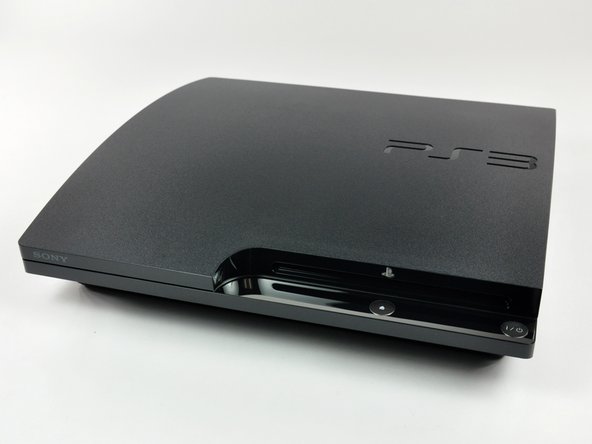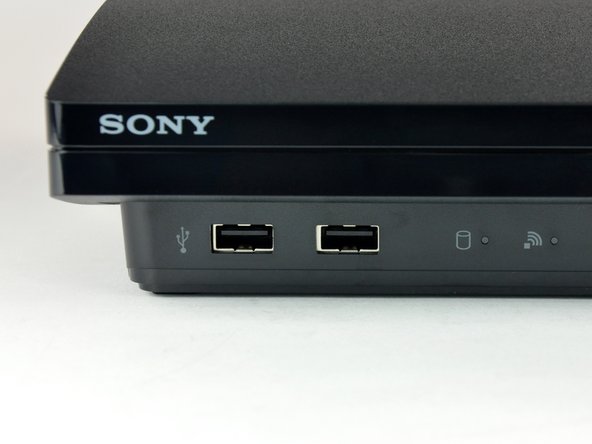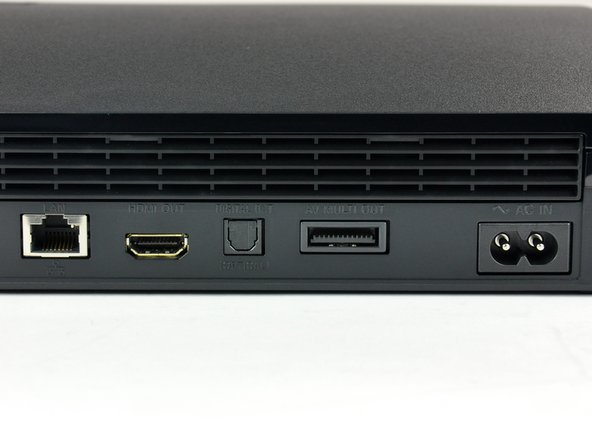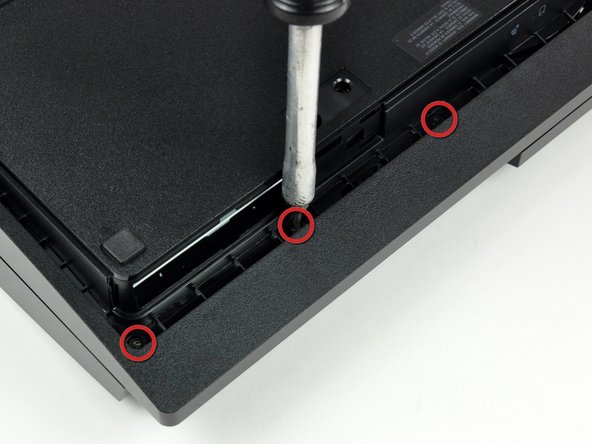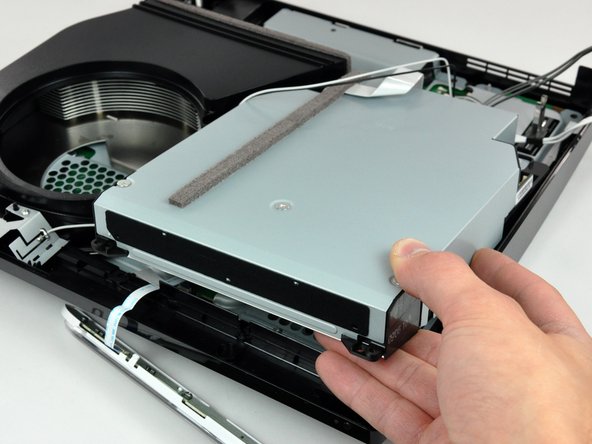PlayStation 3 Slim Teardown
ID: 1121
Description: A first look inside Sony's dramatically...
Steps:
- It's here! We got our dirty hands on a PS3 Slim a full day before it was set to arrive in the mail!
- The box, just like the unit, is, well, slimmer.
- Did you know you can post your own teardown on iFixit? Share what's inside your gadgets! Take apart an old cell phone, microwave, or toy robot.
- Our free online editor makes it super-easy to publish step-by-step teardowns.
- We host everything for free, and make it easy for you to have high-resolution photos, professional layout, and full-screen slideshows like ours!
- Along with the PS3 Slim you get:
- Sixaxis DualShock 3 controller
- RCA Cables
- USB Cable
- Power Cord
- QuickStart Guide and Instruction Manual
- Welcome to PS3 and PS Network Blu-ray Disc
- One of those "Guide to Video Game Ratings" guides that nobody gives a [redacted] about.
- On the front left, we have two USB ports, a hard drive indicator light, and a Wi-Fi indicator light.
- Front right yields a slot-loading Blu-ray drive, power button, and eject button.
- The back has a LAN connection, HDMI port, digital audio-out, multi-connector (RCA or component video) and a new type of power plug.
- Owners of the current-gen PS3s will notice an absence of the rear manual power switch. All your powering needs are now served by the front power button.
- Now that we've dispensed with the pleasantries, let's get into the meat of the subject, so to speak.
- We start with the hard drive first.
- A blue Phillips screw is hidden beneath "the blue Phillips screw cover," as we call it. Remove this screw.
- Next, remove the hard drive cover.
- The drive enclosure has a metal pull tab attached to it. Pull on it to release the drive from the bay.
- The 120 GB Toshiba drive, in all its glory. We have a feeling that it's going to be super-easy to upgrade this drive to 500GB...
- Remove the three (or on some models, four) TR8 security Torx screws on the underside of the PS3 slim.
- What's that, you say? Security screws? Yes, that's right. These screws have a pin in the center of them that prevents an ordinary Torx screwdriver from working. These screwdrivers are widely available, just not quite as easy to come by as a normal Torx.
- Sony did this to prevent people like us from taking it apart.
- Those three TR8 security Torx screws seem to be the only non-Phillips head fasteners on the entire device.
- This seems a little spiteful-- hardware hacking is a fine American tradition. No worries, we'll make sure it's easy for you to get these screwdrivers.
- De-warranty-izing and de-tabbing on the underside of the Slim ensue...
- If you haven't seen them already, check out our dozens of teardowns, ripping apart everything from a cappuccino machine to an iPhone 3GS.
- MacBook Pro 13" Unibody Mid 2009 Teardown
- Palm Pre Teardown
- Banana Teardown
- Seven Phillips screws need to be removed from the bottom.
- Interestingly enough, the rubber pad on the front-right corner of the PS3 has no screw hidden underneath it. Imagine our surprise when we removed it!
- Flip the PS3 over.
- Wait for it, wait for it...
- MEGA FAN revealed!
- This 12V, 1.3A monster rivals the best fans found in desktop PC machines. Sony spared no expense.
- Closeup of the massive fan and controller antennas.
- This is a brushless DC motor, which is fairly standard for fans in devices like this. Brushless motors are quieter than more traditional fans, but require fine computer control to function. It is not a maglev fan like Apple is known to use, however.
- The Bluetooth and WLAN antennas, intentionally three-dimensional in design, are attached to the lower case with Phillips screws.
- Disconnecting two power supply cables.
- The AC inlet cable is devoid of a third 'ground' pin, surprising for a unit that draws nearly 250W.
- Removing the power supply. This is quite a bit smaller than the original PS3's power supply, and presumably has better thermal characteristics.
- Much to the relief of users worldwide, the power supply is designed for inputs ranging from 100V to 240V AC.
- Digging a little deeper into the new power supply.
- This is a startlingly compact unit. It will be interesting to see what the thermal dissipation is like.
- This puppy cranks out 18 amps at 12V DC! Fingers beware.
- This is the largest fan we've come across in a consumer electronics device of this size.
- Sony is really taking cooling quite seriously.
- The ~95 mm diameter 17 blade impeller was definitely designed with quiet in mind. It is extremely stiff and presumably made of ABS plastic.
- Tape holding down antenna and power cables.
- That tape is just begging to be ripped off.
- We indulged.
- A tug at the plug, a twist of the screwdriver...
- ...and the Blu-ray drive comes right out.
- This drive is still quite large, and takes up the bulk of the space inside the PS3.
- We disassembled the drive, and found that it appears to be a proprietary Sony-manufactured part.
- More connectors and screws to unplug/unscrew.
- The design aesthetic of this machine is quite a bit more bare-bones-functional than Apple's, but is still beautiful in its own way.
- Several components, including the AC power inlet, are simply held to the unit by the pressure of the screws connecting the top and bottom cases.
- A few more screws, and the logic board lifts free of the chassis!
- Those three T8 security Torx screws seem to be the only non-Phillips head fasteners on the entire device.
- Unscrewing several screws securing the EMI shield.
- The two identical matte finished brackets in the first picture are designed to apply pressure to the center of the processors, keeping them firmly planted on their heat sinks.
- Separating the metal electromagnetic interference shield from the logic board.
- The whole [slim] enchilada!
- Counterclockwise from the left:
- Power supply, main board, hard drive, EMI shield, heat sink, fan, Blu-ray drive, controller, and plastic case.
- That's it for the disassembly, but we'll continue to post board photos and analysis as the information pours in.
- The logic board. Sony's going green on the inside, to reflect their commitment to the environment.
- We've never seen cool snowflake-like patterns in the thermal paste after we removed a heat sink before. This may indicate that the thermal paste was overapplied or that it was not distributed evenly.
- If you look closely at the thermal paste, you'll see it is a fractal!
- The Cell processor looks very spiffy under our lights.
- We didn't think it was possible to synthesize reality, but the RSX chip (from an Acura?!) proves us wrong.
- Chip labels: RSX Reality Synthesizer CXD2991EGB 0916HFZ 114477
- Multiple manufacturers, multiple functions. The first picture shows two of the four NEC/TOKIN 0e108 capacitors.
- NEC/TOKIN Corporation creates "next-generation, value-added devices that integrate." Whatever that means.
- High Speed Decoupling Device Proadlizer PF/A SeriesProadlizer PF/A Series.
- Dual Elpida 512Mbit RAM chips (there are four total on the board).
- The third picture shows, from left to right:
- Marvell Ethernet controller
- Panasonic HDMI controller
- Sony AV multi-out controller
- But wait -- there's more!
- Clock generators from left to right:
- Clock generator (1): ICS 9249AGLF
- Clock generator (2): ICS 1493DG
- Samsung K8Q2815UQB-PI4B
- SW2-301 0920KMOOT
- Sony CXD9963G8
- We put the latest iPod Shuffle on top of the processor. The shuffle is just slightly longer, but the overall area of the processor is vastly larger.
- Roll call: all parts and pieces, assemble!

